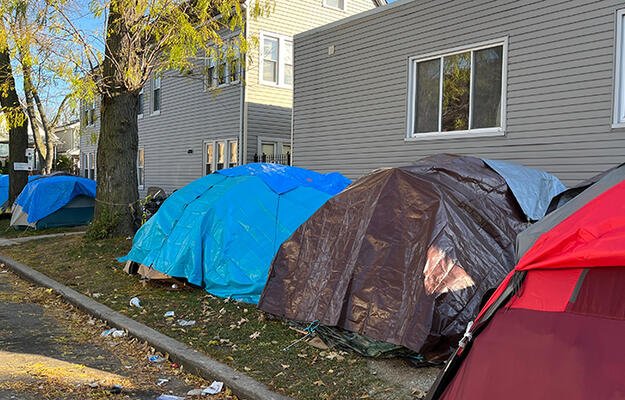
(Kusska/Shutterstock)
What Policymakers Need to Know about Racism in the Property Tax System
Most local governments rely on property taxes to fund amenities and services for their residents, including public schools, libraries, roads, parks, and other public services. Property tax rates vary significantly by locality but generally are calculated based on assessments of property values conducted by local assessors’ offices. That means that if assessed values are accurate, property owners are paying a flat tax, with each household contributing the same share of their property value.
But evidence suggests property taxes actually function as a regressive tax, meaning they take a higher income percentage from households with low incomes than from those with high incomes. This regressivity is linked with systemic racism in the US housing system, resulting in homeowners of color, particularly Black homeowners, paying disproportionately high property taxes relative to the market value of their homes. State and local policymakers have a few options to address these disparities.
Racist histories of property tax implementation and enforcement
Historically, property taxes were used as a mechanism for benefitting white landowners while harming Black communities. Take, for instance, Alabama’s constitutional property tax limits, which were adopted during its 1875 and 1901 constitutional conventions. In response to advances in civil rights for Black Americans during the Reconstruction period, these conventions were held to “establish white supremacy in this state.” Convention participants implemented restrictive property tax limits to ensure white landowners wouldn’t be responsible for funding education and other public services for Black Alabamans.
Property taxes often served as an explicitly racist means for burdening Black households. In the Jim Crow South, assessors’ offices routinely imposed significantly higher tax burdens on Black landowners than on white ones while preventing those tax dollars from benefiting Black communities.
Local governments also used property taxes to punish Black landowners who participated in civil rights organizing. In Edwards, Mississippi, for example, the white-run local government responded to Black residents’ boycott of local businesses by raising the assessment values of Black boycott participants’ properties; from 1965 to 1966, the average Black property owner experienced an assessment increase of 52.6 percent.
The persistence of inequitable property taxation
Recent headlines have highlighted how racial inequities in property taxation persist today. A Chicago Tribune analysis of more than 100 million 2003–15 property tax records found that the Cook County assessor’s office regularly overvalued homes in working-class neighborhoods and neighborhoods of color, while underassessing homes in the county’s wealthier and whiter areas. Detroit, where more than three-quarters of the population is Black, overassessed the property value of 53 to 84 percent of homes from 2009 to 2015. Between 2010 and 2019, homes in poor and predominantly Black neighborhoods in Franklin County, Ohio, were overvalued by up to 50 percent relative to their market values.
Evidence suggests the overassessment of Black homes isn’t a problem distinct to certain localities but is a nationwide issue. A study of more than 118 million homes across the US from 2003 to 2016 found that Black and Hispanic residents paid, on average, 10 to 13 percent more in property taxes for the same bundle of public services. The average assessment ratio (the ratio of a property’s assessed value to its market value) was 12.7 percent higher for a Black resident than a white resident.
These findings are especially concerning given that Black homeowners own, on average, lower valued homes than any other racial or ethnic group. These lower values stem from a variety of contributing factors, including systemic disinvestment from and segregation of Black communities, and appraisers’ use of the sales-comparison approach, which pulls forward historic undervaluation over time.
Essentially, many Black households are subject to low market valuations in combination with property tax overassessments—meaning the wealth-building benefits of homeownership are limited while its costs are disproportionately high.
What explains these disparities?
Part of the problem is that as long as race and class remain linked, facially neutral tax policies can have decidedly unneutral outcomes. Consider the mortgage interest deduction, a tax policy that allows homeowners to subtract mortgage interest from their taxable income, thereby lowering their payment. Because white households are the most likely to own homes, this ostensibly race-neutral policy has the effect of disproportionately benefiting white households. By contrast, renters are more likely to be people of color and lack a similar deduction option.
In the case of property taxes, many states and localities impose restrictions by capping tax rates, assessment values, and year-to-year adjustments. Some of these policies were instituted with good intentions; others, like Alabama’s and those of some other Jim Crow states, were originally passed with the goal of protecting white landowners from funding public services and shouldering Black households with greater burdens. But with explicitly racist intentions or not, these types of policies tend to advantage wealthier homeowners with higher-valued homes, a group of people more likely to be white.
Per the authors of the nationwide study of overassessments, another driving force behind property tax disparities is that neighborhood characteristics differ significantly between neighborhoods of color and white neighborhoods. Residential segregation and disinvestment from communities of color have resulted in these communities having less access to amenities like well-funded public schools and accessible green space. The authors assert that these neighborhood differences are likely to be reflected in sales prices, but assessments often fail to capture them. Another study of racial disparities in property taxes also suggests that because of data and modeling limitations, property tax assessments fail to account for property features that are obvious to borrowers and sellers (and therefore reflected in the market price).
But homeowners of color are more likely to experience overassessments even when they have similar neighborhood characteristics as white households. And research suggests homeowners of color tend to be less successful in appealing their assessed values. From 2003 to 2016, homeowners of color in Cook County were less likely to appeal their assessments, less likely to win when they did appeal, and typically received smaller property tax reductions when they did win their appeals. And from 2005 to 2009, white homeowners in Miami-Dade County who appealed their assessment were more likely to receive a reduction in their assessed value, even when controlling for assessment error and preappeal assessed value.
Local policymakers can take steps to ensure equitable property tax assessments
Property taxes represent the intersection of a few different racial equity issues, which local policymakers have some of the tools to solve. They can consider:
- Implementing oversight for assessments: To advance property tax equity, local policymakers should first consider implementing additional oversight mechanisms in their assessment processes. Many of the reports and articles on property tax disparities have emerged from analyses conducted by outside parties, like academics and local media. Localities seeking to advance property tax equity could implement accuracy checks and racial equity analyses earlier in the assessment process to ensure residents of color aren’t unfairly burdened.
Some localities, like St. Paul, Minnesota, have created racial equity assessment toolkits that help policymakers and practitioners evaluate the impact of city services, policies, and programs on residents of color. Many assessors’ offices stand to benefit applying a similar racial equity lens and making continued adjustments to assessment methods as necessary.
- Expanding tax relief programs: Property tax relief programs are also an evidence-based option for reducing the burden on homeowners of color and homeowners with low incomes. Many states offer such programs already in the form of homestead exemptions, which allow qualified homeowners to exclude some of the value of their property from being taxed, and circuit breakers, which limit or refund taxes for certain homeowners, typically based on household income.
These programs may help offset regressivity in the property tax system by shifting tax subsidies from wealthier homeowners to homeowners with lower incomes. They can also improve residential stability by protecting residents of color from gentrification, which drives up property taxes and can subsequently lead to displacement. Currently, many states offering circuit breakers only do so for elderly or disabled households and households with very low incomes; expanding these programs to include more residents could advance racial equity in property taxation.
- Reducing housing segregation: Finally, localities looking to improve racial equity could seek to reduce racial residential segregation and direct investment toward historically excluded communities, which could resolve disparate access to amenities between white neighborhoods and neighborhoods of color. As mentioned, these differences in amenities are often reflected in market prices but not assessment values, leading to the overassessment of homes of color. But on a more fundamental level, segregation as a structure makes it easier for local governments to discriminate against people of color using place-based strategies like exposure to environmental hazards, disinvestment in schools and other public services, and the overassessment of property values in communities of color.
To combat residential segregation, policymakers could consider desegregation and equitable investment strategies such as updating community engagement methods to incorporate feedback from underserved populations, implementing inclusionary zoning policies and practices, and providing tools for affordable development financing.
Racial disparities in property taxation illuminate the inextricability of race and class—regressivity in the property tax systems results in households of color bearing a disproportionate burden. But even when accounting for income, homeowners of color, especially Black homeowners, still tend to have their property values overassessed. To improve property tax equity, state and local policymakers will need to make a concerted effort to root out systemic racism and to ease tax burdens for residents of color.


